#Android or iOS which is better
Explore tagged Tumblr posts
Text
Android vs iOS - Which OS is right for you?
Over the years, the debate between Android and iOS has intensified, making it vital for you to understand the unique features each operating system offers. Android provides a wide range of devices with customizable options, while iOS boasts a seamless user experience and consistent updates. Your choice can impact everything from app availability to device performance. Whether you prioritize…
#AI-powered mobile operating systems#Android benefits#Android customization options#Android features#Android flexibility vs iOS simplicity#Android market share vs iOS#Android or iOS which is better#Android vs iOS#Android vs iOS comparison#Android vs iOS for app development#Android vs iOS for gaming#Android vs iOS performance analysis#Android vs iOS security features#Android vs iOS user experience#best mobile operating system#choose between Android and iOS#choosing the right OS for developers#cross-platform app development Android vs iOS#generative AI apps on Android#generative AI apps on iOS#generative AI in mobile apps#iOS benefits#iOS exclusive features#iOS features#iOS smoothness and stability#mobile apps on Android vs iOS#mobile operating system trends#mobile OS comparison#mobile platform comparison for AI#next-gen mobile technologies comparison
1 note
·
View note
Text
girlies i'm shaking, why am i thinking about getting an iphone as my next phone
#i've ONLYYYY ever had samsung#but i'm so fucking annoyed with the new android update that makes it look like an iphone#+ been holding onto my s20 for 5 years now bc it's the last phone with an SD slot which was the no.1 reason i preferred android over ios#+ i'm always so annoyed that samsung has better cameras but it never translates bc apps are better suited for iphones SIGH#also i do have a macbook and having an iphone would def be easier in that regard as well
2 notes
·
View notes
Text
React Native or Native: Which Is Superior for Developing Apps?

In today’s digital ecosystem, mobile applications are pivotal for engaging users and driving business success. One of the earliest decisions developers and business owners must make is choosing the right technology for their mobile apps: React Native or Native development. Each option brings distinct advantages and trade-offs depending on the project's needs, budget, and long-term goals. This blog explores the strengths and limitations of both approaches to help you determine which is superior for your app development journey in 2025 and beyond.
Understanding the Basics: What Is React Native and Native App Development?
React Native is a popular open-source framework created by Meta (formerly Facebook). It allows developers to build cross-platform apps using JavaScript and React. With a single codebase, developers can deploy apps on both Android and iOS, significantly reducing development time and cost.
On the other hand, Native app development refers to building mobile applications specifically for a single platform—Android or iOS—using languages and tools provided by the platform vendor. For Android, this usually means using Java or Kotlin in Android Studio; for iOS, it's Swift or Objective-C in Xcode.
Performance: React Native vs Native App Development

When it comes to performance, native apps generally have the upper hand. Because they’re built using platform-specific languages and APIs, native apps offer smoother animations, better response times, and faster execution. This is especially important for apps that require heavy processing, advanced graphics (like AR/VR or gaming apps), or deep integration with the device hardware.
React Native apps, while impressive in reach and flexibility, rely on a JavaScript bridge to communicate with native modules. This can introduce latency and performance bottlenecks in high-performance applications. However, for many standard use cases—such as e-commerce, social networking, or booking apps—React Native performance is sufficient and increasingly optimized with tools like Hermes engine and JSI (JavaScript Interface).
Keyword tip: Businesses often search for terms like React Native vs Native performance, making it a core comparison factor in decision-making.
Development Speed and Cost: Why React Native Wins

If you’re working with limited time and budget, React Native app development services may be your best bet. With a single codebase for both iOS and Android, developers can create apps faster and cut costs significantly, sometimes up to 40–50% less than building two native apps.
Furthermore, code reusability, live reloading, and modular architecture in React Native enhance development speed and team collaboration. For startups or MVPs aiming for rapid time-to-market, React Native offers a compelling solution without compromising on functionality.
In contrast, native development requires separate teams, toolsets, and codebases for each platform, effectively doubling the effort and cost. While this might make sense for enterprise-grade or mission-critical apps, it can be overkill for simpler projects.
User Experience and UI: Native Still Leads

Native apps are known for delivering a superior user experience. Since they’re built for a specific operating system, native apps can take full advantage of the platform’s UI guidelines, gestures, animations, and components. The result is an app that feels more integrated and intuitive to the user.
React Native tries to replicate native UI components but can sometimes fall short, particularly with platform-specific design elements or highly customized interfaces. While libraries like React Native Paper and NativeBase offer prebuilt components, native still excels in creating pixel-perfect, fluid UIs.
That said, React Native UI is constantly improving, and for many common use cases, it provides a satisfactory and visually pleasing experience. However, for apps where the user interface is a core differentiator, native development has the edge.
Maintenance and Updates: React Native Simplifies It

From a maintenance perspective, React Native simplifies updates due to its unified codebase. Bug fixes, feature updates, and performance improvements can be rolled out simultaneously across both platforms, streamlining app management.
Moreover, tools like CodePush allow for over-the-air (OTA) updates without requiring users to download a new version from the app store. This is a major advantage for agile teams that need to iterate quickly.
Native apps, however, need platform-specific maintenance and updates, which increases the workload and risks inconsistent feature parity between platforms.
Access to Native APIs and Device Features

If your app requires extensive use of native APIs, sensors, or background services (such as Bluetooth, GPS tracking, biometric authentication, or background video processing), native development offers direct access and better control.
React Native, while offering access to many native modules through libraries or custom bridging, can sometimes lag in supporting the latest native APIs immediately. In such cases, native development provides a smoother path to integrate cutting-edge features.
However, React Native has made significant progress in this area with tools like React Native Reanimated, React Navigation, and community-driven modules that support a wide range of native features.
Community Support and Talent Availability

React Native benefits from a massive and active open-source community. With thousands of contributors and extensive documentation, finding React Native developers is relatively easy, and solutions to common issues are readily available.
While native app development also has strong community support, especially for Android and iOS individually, it may require more specialized expertise, which can increase hiring costs and development time.
From a talent acquisition perspective, React Native offers broader flexibility. Developers familiar with JavaScript and React can transition into mobile development more easily than native development, which demands platform-specific knowledge.
Long-Term Scalability and Security

For apps requiring high scalability, robust security, and tight hardware integration—such as banking, fintech, or healthcare apps—native development is often preferred. The performance stability, access control, and OS-level security features make native apps better suited for enterprise-grade solutions.
React Native apps can scale well too, especially with proper architectural planning and the use of native modules. However, security can be a concern if the JavaScript layer isn’t handled properly. Obfuscation, secure storage, and regular audits are essential when using React Native in sensitive domains.
When to Choose React Native
Choose React Native app development if:
You need to build apps for both iOS and Android quickly.
Budget and time constraints are important.
The app doesn't require complex animations or high-performance hardware access.
You're building an MVP or prototype to test the market.
You want faster iterations and simplified maintenance.
When to Choose Native App Development
Choose native app development if:
The app requires maximum performance, such as 3D games or AR/VR apps.
You need to integrate deeply with device hardware or native APIs.
Security and scalability are top priorities (e.g., in fintech or healthcare).
UI/UX customization is a critical part of your user engagement strategy.
You have the resources to maintain separate codebases for iOS and Android.
Final Verdict: Which Is Superior?
There’s no one-size-fits-all answer. The superior approach—React Native or Native—depends entirely on your project’s goals, complexity, and constraints. React Native is a great choice for startups, cross-platform solutions, and rapid development. Native development, on the other hand, remains unbeatable for performance-critical, secure, and UI-intensive applications.
Partnering with the right mobile app development company is key to evaluating your needs and choosing the best technology. Whether you opt for React Native or native app development, ensure that your chosen team has deep expertise and a clear understanding of your industry requirements.
#Which is better React Native or Native for app development#React Native vs Native app performance comparison#Cost-effective mobile app development in 2025#Best choice for cross-platform app development#Choosing between React Native and Native in 2025#React Native performance#Native app advantages#React Native pros and cons#Native vs cross-platform development#Swift and Kotlin app development#Best framework for mobile app development#iOS and Android app development#Mobile development technologies 2025
0 notes
Text
Tuesday, January 30th, 2024
🌟 New
You can now add polls to reblogs!
When searching on a specific blog, using a # as a prefix will now only match tags. So if you search for #cats on a blog, we’ll only show posts using that tag. (This is also how searching across all of Tumblr works when using a # to prefix a search term.)
We’ve retired the Today tab in Explore on web, now Trending is the default experience again.
🛠 Fixed
Posting to Tumblr from IFTTT was being rate limited more than usual lately, causing some actions to fail, but we’ve fixed the issue.
We’re fixing lots of small visual issues with Tumblr Patio, for those who are helping us test it out.
On Android, a small number of users were unable to access their messages on app version 32.9. This issue is now fixed in 33.0.
We’ve rolled out the fix to issue in the iOS app that was preventing folks from editing draft posts.
🚧 Ongoing
We attempted to fix the pesky bug that could cause the asks/submissions inbox to show an unread count of 1 or more when nothing was actually in there. This is usually caused by someone sending an ask, and then being suspended for some reason, or blocking, which all prevent the actual ask from being seen. We accidentally made this worse for some people, showing an even higher unread count when nothing was there. While we fixed that botched attempt at a fix, we’re still working to make the situation better overall.
🌱 Upcoming
Nothing to report here today.
Experiencing an issue? File a Support Request and we’ll get back to you as soon as we can!
Want to share your feedback about something? Check out our Work in Progress blog and start a discussion with the community.
Wanna support Tumblr directly with some money? Check out the new Supporter badge in TumblrMart!
1K notes
·
View notes
Text
People should really consider using Tumblr mobile web instead of the app. It means your Tumblr account isn't directly beholden to app store companies, ie Apple and Google, so it hasn't experienced the automatic user settings changes to suppress mature content that ios and android users have both now experienced.
You're also taking your business away from app stores by using mobile web, especially if you pay for a tumblr subscription via an app store (I mean, idk who does lol but just saying). You'd still be using a browser app of course but you can choose which browser fits your needs & privacy level preferences (including choosing not to use Chrome), and deleting the Tumblr app is one less app downloaded, one less app scraping your personal information. It obviously doesn't impact what content is labeled as mature, but it's a drop in the bucket as far as making your Tumblr account one extra step removed from app store control.
Mobile web is the neglected stepchild of Tumblr updates, too, and that's a great thing lmao. The updates we do get are the ones that are more solid quality-of-life improvements and better tested before they get released, in my experience anyway.
Mobile web usually doesn't get all the flashy new updates right away or frequent UI changes that the apps get (I hate that kind of stuff so it's a plus for me lol), I find the UI much more straightforward and simple from my brief flings with the app, and experiences less bugginess from what I read on the @/changes official account.
So, app store is making it more difficult to access adult content? Don't use the app!
118 notes
·
View notes
Note
Genuine question, if Apple sucks and Google sucks, what phone do I get? Like, I'm a proponent of Fuck Google, but I have an Android cause I'm a bigger proponent of Fuck Apple, and I don't really have a great way to reconcile these feelings of conflict
I address this a bit in the degoogling pamphlet; iphones are genuinely better for privacy and I think the phone side of apple is less terribly reprehensible than the computer side if for no other reason than market forces prevent them from gouging quite as excessively. If you own an android your best bet is to turn off location data (everyone should be doing this for all of their devices anyway) uninstall as many apps as possible, force stop or disable as many apps as possible, deny every possible permission it is possible to deny, and never use your phone for sensitive work.
Your other option is to look into linux phones, which are out there, but don't have the same kind of app ecosystem or broad support as ios or android.
And the thing that I really think everyone should do that nobody actually likes hearing is to stop using your phone as anything but a phone. They can't track your data if you don't use it. I recognize that people need phones now in a way they didn't in the past (2fa is a huge part of this; people are either using SMS or apps to verify and that means it's not as easily dismissed as a necessity as it was 10 years ago) but there's a huge part of me that's like "I want to replace my smartphone with a jitterbug."
If you can't actually replace your smartphone with a jitterbug you can at least pretend that it isn't anything but a phone with a few limited extra tools.
(Also this is my "the boomers are right about..." thing: everyone should uninstall navigation applications and go back to reading maps and pre-planning their route to their destination)
1K notes
·
View notes
Text
Why Millennials aren’t leaving Tiktok

I'm on tour with my new, nationally bestselling novel The Bezzle! Catch me TOMORROW NIGHT (Mar 22) in TORONTO, then SUNDAY (Mar 24) with LAURA POITRAS in NYC, then Anaheim, and more!

The news that Gen Z users have abandoned Tiktok in such numbers that the median Tiktoker is a Millennial (or someone even older) prompted commentators to dunk on Tiktok as uncool by dint of having lost its youthful sheen:
https://www.garbageday.email/p/tiktok-millennials-turns
But "why are Gen Z kids leaving Tiktok?" is the wrong question. The right question is, why aren't Millennials leaving Tiktok? After all, we are living through the enshittocene, the great enshittening, in which every platform gets monotonically, irreversibly worse over time, and Tiktok is no exception:
https://pluralistic.net/2023/01/21/potemkin-ai/#hey-guys
To understand why older users are stuck to Tiktok, we need to start with why younger users relentlessly seek out new platforms. To some extent, it's just down to youth's appetite for novelty, but that's only part of the story. To really understand why people come to – and leave – platforms, you have to understand switching costs.
"Switching costs" is the economists' term for everything you have to give up when you change products or services. Switching from Ios to Android probably means giving up a bunch of your apps and purchased media. Switching from an airline where you're a high-status frequent flier to another carrier means giving up on free checked bags and early boarding.
In an open market, rivals have lots of ways to lower these switching costs (it's an open secret that you can call an airline and say, "Hi, I'm a 33rd Order Mason on American Airlines, will you make me a Triple Platinum Diamond Sky-Baron if I switch to Delta?"). Of course, big incumbents hate this, and do everything they can to increase their switching costs, finding ways to impose high switching costs that punish disloyal consumers who have the temerity to go elsewhere.
With social media, lock-in comes for free, thanks to the "collective action problem." Getting people to agree on a given course of action is hard, and as you add more people to the picture, the problem gets harder. It's hard enough to get half a dozen people in your group-chat to agree on where to go for dinner or what board-game to play. But once you're reliant on a social media service to stay in touch with friends, relatives around the world, customers, communities (say, rare disease support groups), and coordination (like organizing your kid's little league car-pool), the problem becomes nearly insoluble. Maybe you can convince your overseas relatives to switch to a Signal group, but can you do the same for your small business's customers, or your old high-school pals?
https://pluralistic.net/2022/10/29/how-to-leave-dying-social-media-platforms/
Taken together, switching costs and collective action problems make platforms "sticky," and sticky platforms inevitably enshittify.
Platforms, after all, generate value. They connect end-users with each other (say, little league parents) and they connect end-users to business customers (you and your small business's customers). That value needs to be parceled out among end users, business customers, and the platform's shareholders. A platform can make life better for business customers at its end users' expense by increasing the number of ads (hello, Youtube!), and it can make life better for its shareholders at its business customers' expense by decreasing the share of ad revenue given to publishers or performers (oh, hello again, Youtube!).
From a platform's perspective, the ideal state is one in which end users and business customers get no value from the platform, because it's all being captured by the platform's shareholders. But if Youtube interrupted every 30 seconds of video for ten minutes of ads and paid the video creators nothing, both users and creators would ditch the platform – and advertisers would follow:
https://www.youtube.com/watch?v=Dab8sKg8Ko8
So platforms seek an equilibrium: "what is the least value we apportion to end-users and business customers without triggering their departure?" Maybe that means giving more value to end-users (for example, keeping Uber fares low by suppressing wages), or to business-customers (crowding more ads into your social media feed).
Every business – including brick-and-mortar, non-digitized ones – wants to find some kind of equilibrium between the value going to its suppliers, its customers and its owners, but digital businesses have an advantage here: digital systems are flexible in ways that analog, hard-goods businesses are not. Digital businesses can alter pricing, payouts and other dynamics from moment to moment – second to second – and make a different offer to every supplier and customer. They have a bunch of knobs, and they can twiddle them at will:
https://pluralistic.net/2023/02/19/twiddler/
Well, not quite at will. Businesses face constraints on their twiddling. If they get too greedy, users or business customers might weigh the cost of staying against the switching costs and decide it's not worth it. But the more expensive – the more painful – a platform can make leaving, the more pain they can inflict on the people who stay.
In other words, there's two ways to keep a customer or supplier's business: you can make a better service so they won't want to leave, or you can make leaving the service so painful that they stay even if you mistreat them.
There's three ways a digital company can make things worse for their customers and users without losing their business.
First, they can eliminate competition (think of Mark Zuckerberg buying Instagram to recapture the users who'd fled Facebook to escape his poor management):
https://pluralistic.net/2023/09/03/big-tech-cant-stop-telling-on-itself/
Second, they can capture their regulators and avoid punishment for trampling their suppliers' or users' legal rights (think of how Amazon has raised the price of everything we buy, both on- and off Amazon, through its "most favored nation" deals):
https://pluralistic.net/2023/04/25/greedflation/#commissar-bezos
Third, they can use IP law to prevent competitors from modifying their services to claw back some of that value (think of how Apple used legal threats to block an Android version of Imessage, blocking Apple customers from having private conversations that included non-Apple customers:
https://pluralistic.net/2024/01/12/youre-holding-it-wrong/#if-dishwashers-were-iphones
Companies can't just use this tricks at will, of course. Antitrust laws can block companies from making anticompetitve acquisitions or mergers. Regulators can punish companies for cheating their customers, workers and users. Technologists can come up with clever ways of modding or reconfiguring existing services with "interoperable" add-ons that let users bargain for better treatment by refusing to accept worse:
https://www.eff.org/deeplinks/2019/07/adblocking-how-about-nah
Day in, day out, the decision-makers at tech companies test these constraints, twisting the knobs that shift value away from users to shareholders. Their bosses and boards motivate them with "KPIs" that dangle the promise of huge bonuses and promotions for any manager who successfully enshittifies part of the company's products:
https://pluralistic.net/2023/07/28/microincentives-and-enshittification/
Decades of pro-corporate, pro-monopoly policy has loosened those knobs. 40 years of lax antitrust meant that companies had a lot of leeway to buy or merge with rivals – that's changing today, but it's tough sledding:
https://pluralistic.net/2023/07/14/making-good-trouble/#the-peoples-champion
As sectors grew more concentrated, they found it easier to capture their regulators, so that they no longer fear punishment for price-gouging, spying, or wage-theft, so applying the same amount of torque to the "break the law" knob cranks it a lot further:
https://pluralistic.net/2022/06/05/regulatory-capture/
Once you've captured your regulators, you can aim them at your competitors. A monopoly-friendly policy environment has transformed IP law into a bully's charter, allowing powerful companies to strangle would-be competitors who dare to offer their customers tools to shield themselves from enshittification, like scrapers, ad-blockers and alternative clients. Big companies can crank the enshittification knob all the way over and know that smaller rivals knobs won't turn at all:
https://pluralistic.net/2022/10/20/benevolent-dictators/#felony-contempt-of-business-model
At one point, bosses faced one more constraint on knob-twiddling: their workforce. Many tech workers genuinely cared about their users' welfare, something bosses encouraged as a sneaky trick to get techies to put in long hours without exercising their leverage by quitting rather than destroying their lives to meet arbitrary deadlines. These workers would fearlessly slap their bosses' hands when they reached for the enshittification knob, threatening to quit rather than allowing the products they'd given so much for to be enshittified. Today, after hundreds of thousands of tech layoffs, tech workers are far less like to challenge their bosses' right to twiddle, and far more likely to get fired if they try:
https://pluralistic.net/2023/09/10/the-proletarianization-of-tech-workers/
All this means that tech bosses don't have to change their approach at all, and yet, their services will grow steadily worse. The boss who twiddles the enshittification knob in exactly the same way as he did a year or a decade ago will find it turning much further, because his customers are locked into his platform, his regulators won't protect them, the same regulators will stop his competitors' attempts at countertwiddling, and his workers fear losing their jobs too much to speak up for their users.
That's the contagion that produced the enshittocene: the forces that constrained companies (competition, regulation, self-help and labor – all melted away, allowing every company's MBA-poisoned knob-twiddling leaders to shamelessly caress their knobs with every hour that God sends:
https://pluralistic.net/2024/01/30/go-nuts-meine-kerle/#ich-bin-ein-bratapfel
Which is why people want to leave platforms. When a platform loses its users, those users have weighed the switching costs against the pain of staying and decided that it's better to bear those costs than to stay.
So why have Tiktok's younger users found the costs too high to bear, and why have their elders remained stuck to the platform?
For that, we have to look at the unique characteristics of young people – characteristics that transcend the lazy cliche that kids are easily bored, fickle novelty-seekers who hop from one service to another with unquenchable restlessness.
Whether or not kids are novelty-seekers, they are, fundamentally, a disfavored minority. They want to do things that the platforms don't want them to do – like converse without being overheard by authority figures, including their parents and their schools (also: cops and future employers, though kids may not be thinking about them as much).
In other words, kids pay intrinsically lower switching costs than adults, because a platform will always do less for them than it will for grownups. This is a characteristic kids share with other supposedly technophilic, novelty-seeking "early adopters," from sex-workers to terrorists, from sexual minorities to trolls, from political dissidents to fascists. For those groups, the cost of mastering a new technology and assembling a community around it is always more likely to be worth bearing than it would be for people who are well-served by existing tools:
https://pluralistic.net/2022/06/21/early-adopters/#sex-tech
Pornographers didn't jump on home video because of its superiority as a medium for capturing flesh-tones. Home video was a good porn medium because it was easier to discreetly get into the hands of porn consumers, who could, in turn, discreetly view it. The audience for porn in the privacy of your living room is larger than the audience for porn that you can only watch if you're willing to be seen marching into a dirty movie theater.
Every new technology is popularized by a mix of disfavored groups and neophiles, who normalize and refine it – and yes, infuse it with their countercultural coolth – until it becomes easy enough to use to become mainstream. As more normies drift into the new system, the switching costs associated with leaving the old system declines. It gets easier and easier to find the people and services you want in the new realm, and harder and harder to find them in the old one.
This is why tech platforms have historically experienced sudden collapse: the platform that gets more valuable and harder to leave as it accumulates users gets less valuable and easier to leave as users depart:
https://www.zephoria.org/thoughts/archives/2022/12/05/what-if-failure-is-the-plan.html
If you're a Gen Z kid on Tiktok, you experience the same enshittification as your Millennial elders. But you also experience an additional cost to staying: as late-arriving adult authority figures become more fluent in the platform, they are more able to observe your use of it, and punish you for conduct that you used to get away with.
And if you're a Millennial who isn't leaving Tiktok, it's not just that you experience the same enshittification as those departing Gen Z kids – you also face higher switching costs if you go. The older you get, the more complex your social connections grow. A Gen Z kid in middle school doesn't have to worry about losing touch with their high-school buddies if they switch platforms (they haven't gone to high school yet – and they see their middle school friends in person all the time, giving them a side-channel to share information about who's leaving Tiktok and where they're headed to next). Middle-schoolers don't have to worry about coordinating little league car-pools or losing access to a rare disease support group.
In other words: younger people leave old platforms earlier because they have more to gain by leaving; and older people leave old platforms later because they have more to lose by leaving.
This is why Facebook is filled with Boomers. Yes, their kids bolted for the exits to avoid having their parents (or grandparents) wading into their sexual, social and professional lives. But the reason the Boomers were late joining younger users' Facebook exodus – or the reason they never joined it – is that they stand to lose more by going. Facebook deliberately cultivated this dynamic, for example, by creating a photo hosting service designed to entice users into uploading their family photos while disguising how hard it would be to take those photos with them if they left:
https://www.eff.org/deeplinks/2021/08/facebooks-secret-war-switching-costs
The irony here is that tech has intrinsically low switching costs. All other things being equal, a new platform can always build a bridge to ease the passage of users from the old one. There's no (technical) reason that moving to Mastodon, or Bluesky, or any other platform should mean cutting ties with the people who stayed behind.
A combination of voluntary interoperability (where old platforms offer APIs to allow new services to connect with them), mandatory interop (where governments force tech companies to offer APIs) and adversarial interop (where new companies hack together their own API with reverse-engineering, scraping, bots, and other guerrilla tactics) would hypothetically allow users to hop between networks as easily as you change phone carriers:
https://pluralistic.net/2022/12/19/better-failure/#let-my-tweeters-go
Tech platforms tend to offer APIs when they're getting started (to ease the inward passage of new users) then shut them down after they attain dominance (locking the door behind those users). The EU is tinkering with mandatory APIs through the Digital Markets Act (though bafflingly, they're starting with encrypted messaging rather than social media). Restoring adversarial interoperability will require extensive legal reform, which is getting started through Right to Repair laws:
https://www.techdirt.com/2024/03/13/oregon-passes-right-to-repair-law-apple-lobbied-to-kill/
The people who are stranded on social media platforms shouldn't be mistaken for uncool, aging technophobes. They're not stubborn, they're stranded. Like the elders who can't afford to leave a dying town after the factory shuts down and the young people move away, these people are locked in. They need help evacuating – a place to go and a path to get there.

Name your price for 18 of my DRM-free ebooks and support the Electronic Frontier Foundation with the Humble Cory Doctorow Bundle.

If you'd like an essay-formatted version of this post to read or share, here's a link to it on pluralistic.net, my surveillance-free, ad-free, tracker-free blog:
https://pluralistic.net/2024/03/21/involuntary-die-hards/#evacuate-the-platformsr
432 notes
·
View notes
Note
I'm certain you have said it before, but can you point me toward where/what app you use to listen to podcasts these days? I lost the app I was using (apparently it is no longer supported? or something) and I want to get back into listening to them now that NaClYoHo is giving me greats recs
Oh sure! I use PodcastAddict -- though I caveat that it's only available for Android. (Honestly if you have iOS, the last time I checked the native podcatcher was one of their better apps and is very similar to Addict, so if you don't like the iOS catcher you probably wouldn't like Addict anyway. I just hated Android's native catcher, which lacked features I wanted.)
There's a free version with ads -- it's not pop-over ads, just a little banner at the bottom -- but you can also make a one-time payment to get the ads removed. There's also a $10/yr "premium" subscription that removes the ads and gives you access to some small but convenient extra features. The subscription also helps support its ongoing existence, since it's run by like one dude and needs his full-time attention.
My absolute favorite feature, which I believe is available across versions, is that you can enter a feed for a paid podcast and subscribe to it -- so like, I support a handful of podcasts through Patreon, and I can enter the Patreon "paid" feeds for those and get the paid bonus episodes sent straight to the catcher, thus avoiding Patreon's heinously bad podcast interface.
It's the #1 podcatcher on the Google Play store, and just a great example of an app that was built to do a specific thing, does it well, doesn't change unless it's to upgrade something, and offers extremely reasonable levels of access. I think in all the time I've had it, the interface hasn't significantly changed even once, which I treasure in an app.
72 notes
·
View notes
Text
If airports weren’t already a hellscape, TikTok has found a way to make them worse. Welcome to airport theory, a viral delusion that suggests you can roll up to the airport 15 minutes before boarding, waltz through security, and still make your flight with time to spare. No stress, no waiting, just pure main character energy.
TikTok creators like Michael DiCostanzo (@michael.dicostanzo) swear by it, documenting their dashes through high-traffic hubs like LAX, Atlanta International Airport, and post–Super Bowl New Orleans. Some viewers are sold. Others are calling BS.
“So you had PreCheck, didn’t check a bag, and were at the nearest terminal? Now let’s do it when it’s not the optimal situation,” one user commented. And, sure enough, the internet is also littered with failed attempts—videos of forlorn TikTokers watching their flights take off without them, their carry-ons full of regret.
It’s a fun fantasy, which explains why “airport theory” has racked up over 400 million views on TikTok. Unfortunately, the the Transportation Security Administration doesn’t care about your viral moment. The national average wait time for security was 27 minutes, 16 seconds in 2024. And if you’re flying out of a notorious bottleneck like JFK, Orlando International, or Chicago O’Hare, it’s closer to 40 minutes. Google searches for “I missed my flight what do I do” have spiked 70 percent in the past month, per Google Trends. It’s not hard to connect the dots.
Here is your sad reality check: Airlines still recommend arriving at least two hours before a domestic flight, three for international. Sometimes that buffer feels like overkill. But would you rather rush through the airport with your heart racing or have a few minutes to find your gate, grab a bag of overpriced whatever, and scroll TikTok watching other people miss their flights? That sounds like a much better airport theory to us.
Airport Hacks That Actually Work
The best way to get through airport security unscathed is to move like you’ve done this a hundred times before. A little planning, the right gear, and skipping social media stunts will get you from curb to gate with minimal stress.
Time It Right
Travel off-peak. According to CheapAir, Tuesdays and Wednesdays are often less crowded. Early flights between 5 and 8 am and red-eyes (after 9 pm) tend to have fewer passengers.
Check TSA wait times in advance. The My TSA app (iOS, Android) provides real-time security line updates at major airports.
Get the Right Apps
Download your airline’s app for mobile boarding passes and real-time gate updates.
Get TSA PreCheck. Some credit cards even cover the fee. Global Entry (available at select airports) includes PreCheck and fast-tracks reentry into the U.S. Or consider Clear Plus, which uses biometric scans to bypass ID checks.
Use Mobile Passport Control app (iOS, Android) to submit your customs info beforehand for faster reentry to the US.
Pack Smart
Start with an empty bag. Double-check TSA-restricted items list to avoid accidentally smuggling contraband.
Use a clear toiletry bag. The Calpak Clear Cosmetics Case for $85 is an upgrade from the ziplock bag. If you’re worried about TSA’s liquid restrictions, switch to toothpaste tablets like biöm’s Nobs and use reusable travel bottles. I'm a fan of Reis' Refillable Travel Container set, but I've also used travel kits from Amazon for under $10, and they work just as well.
Go carry-on only. The Away Carry-On for $275 is our favorite, but if you want to avoid Away’s baggage, try Monos ($255) or July ($295).
Track your luggage. If you check a bag, stash an AirTag inside for iPhone users or a Chipolo One Point ($25) or Card Spot ($29) for Android.
Dress for Efficiency
Empty your pockets before security. Stash everything in your carry-on instead of fumbling at the checkpoint.
Keep metal jewelry, watches, and belts in your bag until after screening.
Avoid boots or high-tops. Slip-ons like Allbirds' Tree Runners for $98 and the Rothy’s Driving Loafer for $189—we've raved about them in the past—make security a breeze. If you’re not planning on sprinting through the airport, the Bearpaw Martis Slippers ($70) are ultra-comfy.
Skip bulky outerwear. Coats, hoodies with big pockets, and anything with excessive zippers just slow you down. If you have PreCheck, you can usually keep your shoes, belt, and light jacket on.
Stay Organized
Snap-on Phone Stand & Wallet
If you have an iPhone, invest in a MagSafe wallet to avoid digging through your bag for an ID. Some of our favorites include Casetify ($38), Moft’s Snap-On Phone Stand & Wallet ($30), and ESR HaloLock Power Bank Wallet ($80), which works as a power bank, wallet, and phone stand.
Get a checkpoint-friendly laptop backpacks. Lay-flat designs like Peak Design’s Outdoor Backpack (available in 25L and 45L) speed up screenings.
40 notes
·
View notes
Text
I saw a post about period tracking apps being in danger and they recommended a particular app that wasn't made for it. Which is fine and all, but I'd like to recommend a different one: Euki.
It's made by a nonprofit org and it has a ton of features:
ZERO (yes, zero) personal data collection--it all stays on your device.
According to their privacy policy, "The App does not collect, and is not capable of collecting, any user information." (The downside is if you forget your optional PIN, that's it.)
You can set a PIN. Better yet, if you're being forced to open it and you don't want to, you can enter "0000" and it shows a fake screen!
You can regularly delete data, or do it all at once.
It's bilingual in English and Spanish
It offers period prediction features, a customizable calendar, appointment and medicine reminders, reliable information, and links to other orgs
It's free.
But don't trust only me (and Euki). Trust this peer-reviewed paper in the Public Library of Science; Our Bodies, Ourselves; Consumer Reports; Mozilla; the Vagina Privacy Network (a collaboration between a reproductive health org and the EFF); or Feminist Campus' Callie Wixon (Feminist Campus is a project by the Feminist Majority Foundation).
Get it: https://eukiapp.org. It's available on Android and iOS.
#reproductive rights#pro choice#sex education#psa#Resource#resources#useful#period tracking#reproductive health#privacy#politics#us politics
28 notes
·
View notes
Note

Of the various designs for the fox emoji, which one would you say is your favorite? 🦊
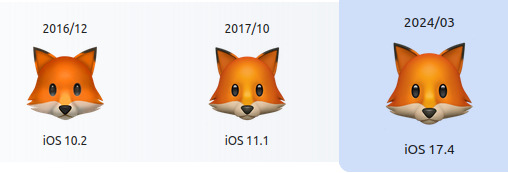
iOS (2016/2017/2024) -- 7/10 that's a cute foxy, but there is a certain cartooony ness about them that lessens their impact

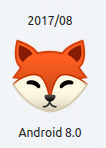
Android (2016) -- 9.5/10 a wilder foxy, with a serious expression, simple and beautiful
Android (2017) -- 9/10 sudden change entirely, thoroughly simplified, but a core foxyness is retained and you get a good smile that can be both adorably whimsical as well as mischievous

Android (2020-2023) -- 5/10 that's a foxy alright, but she borders on being soulless

Samsung (2016) -- 2/10 easily mistaken for some form of rodent
Samsung (2018) -- 6/10 a lot better but a similar problem, the cute eyes do kind of elevate her though
Samsung (2019) -- 5/10 the plushie look helps a bit but very similar

Samsung (2023, 2024) -- 2/10 you could convincingly claim they're hamsters
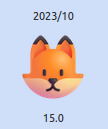
Microsoft 3D fluent (2023) -- 0/10 may the gods have mercy on whoever decided to turn the beautiful Vulpes Vulpes into this abomination of artificial plastic

Microsoft (2016) -- 8/10 a striking shape in a beautiful style, but perhaps a bit too lacking in emotion to capitalize on that
Microsoft (2021, 2023) -- 1/10 it's better than the plastic 3D render but still a crime

Whatsapp (all of them) -- 4/10 not as bad as the samsung hamsters but you could still make the case
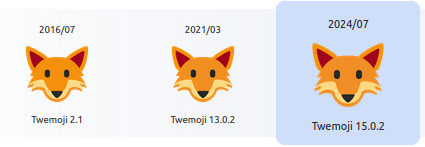
Twitter (all of them) -- 8/10 a cute and fine foxy, again a bit lacking in the emotional department

facebook (2017) -- 9/10 a delightfully whimsical foxy
facebook (2018, 2023) -- ‽⸘/10 this foxy was taken on a boat, gripped at her tail by some sort of tentacle, dragged to the bottom of the ocean where she saw abyssal truths that would be too much for the mind of any creature, and has now miraculously washed up on shore, wet, bedraggled, knowing

Huawei (2023) -- 8/10 this foxy holds many a wisdom

Joypixels (2016) -- 6/10 one day I may welcome our robot fox overlords but that day is not today
Joypixels (2017) -- 8/10 these foxies are young and curious

Joypixels (2018) -- 7/10 a step backwards from above
Joypixels (2019, 2020) -- 6/10 a villainous foxy full of deceit, not necessarily a badly made depiction under that premise but it is a harmful stereotype!

Joypixels (2020, 2023, 2024) -- 4/10 these foxies are being forced to smile fake smiles at 60 hours per week customer service jobs, please free them, they are calling for help

LG (2021) -- 5/10 a long nose lacking in emotion

Twitter emoji stickers (2022) -- 7/10 that's an expensive fursuit head

SerenityOS (2024) -- 1/10 at least with all the other rodents and hamsters you can kind of imagine them to be foxies if you're told that's what they're meant to be, but this? this is a mouse no matter how you look at it
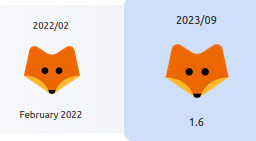
TossFace (2022, 2023) -- -1/10 a corporate abomination


Sony Playstation (2021) -- 8/10 a cutie!
Noto Emoji font (2023) -- 8/10 a black and white cutie!

Openmoji (2018/2023) -- 2/10 could be convincingly claimed to be a kangooroo

Icons8 (2023) -- 5/10 she's old and angry and doesn't like you

emojidex (2016/2017) -- 3/10 these girls are haggard

Emojipedia sample images (2016/2018) -- 2/10 could be confused for rodents again

the girl you sent me without a source -- 8/10 a serious cutie, but she could be mistaken for a wolf
#asks#phew that was a lot of work#<- says the girl who made it that much work on her own will#サンキューリコちゃん^^
52 notes
·
View notes
Text
This might sound crazy but I have this idea for a game based on Objectified for so long and this is the perfect place for me to share it
Objectified: The game
Genre: RPG
Graphics: Based on Unreal Engine 5
Platform: Multi-platform (iOS/Android/Linux/Windows/Xbox/Playstation/ Nintendo Switch (potentially MacOS))
Multiplayer: Yes
Offline mode: Yes
Gameplay:
Story Mode: This is where players can unlock characters, gamemodes and learn about them. Each story will be based 100% off of the original comic and it's interactive. The player can be a part of the story by completing missions in that story (Escape the assimilated objects, finding resources, etc). You can also unlock the Apocalypse Guide here!
PvE: Fight the assimilated objects to farm XP and upgrade your character. In addition, you can use this mode to unlock "Assimilated Repository" which let you learn more about the assimilated objects strengths and weaknesses.
Outer Ring Explorer: Just like the browser game but you can now move more freely!
Multiplayer mode:
- PvP: You can fight with other players using the cast you've obtained before. There will be Solo, Duo, Triple and squad
- Monster Hunter: hunt down the assimilated objects either with a team or by yourself! OR better yet, BE THE ASSIMILATED OBJECTS yourself and hunt everyone down!
- Sandbox Mode: build your own level with the amount of assimilated objects, rules and Weather conditions yourself!
And that's my idea for "Objectified: The Game". Maybe one day this will be a reality but until then this is what I came up with
17 notes
·
View notes
Text
AIR coming to Steam in English on March 5 - Gematsu

Key will release acclaimed romance visual novel AIR for PC via Steam on March 5 worldwide for 3,200 yen, the company announced. It will support English, Japanese, and Simplified Chinese subtitle options with Japanese voice-overs.
AIR first launched for PC on September 8, 2000 in Japan, and has since been ported to Dreamcast, PlayStation 2, feature phones, PSP, iOS, Android, PS Vita, and Switch. While unofficial translation patches have been released by fans, the Steam version marks the first-ever official English release.
Here is an overview of the game, via its Steam page:
About
AIR is the work from the visual novel studio, Key, known for titles such as CLANNAD, Little Busters, Summer Pockets, and more. It received great acclaim and was even adapted into an anime series.
The story evolves depending on the choices you make, providing a variety of different endings to the visual novel’s story for you to discover.
Also includes AIR‘s side story novel, “First Sky Chapter” in visual novel format!
Featuring retouched high-definition visuals and CG coloring!
This version not only offers the best high-definition quality to date, but the game’s CG coloring has also been adjusted to better complement LED display colors. Enjoy the experience with beautiful graphics!
Although the Windows version of AIR has never had voice support before, the Steam version adds full voice support with an amazing cast of actors!
The text can be set to Japanese, English, or Simplified Chinese (audio only available in Japanese). This includes in-game text, options, and the digital manual. Language settings can be changed at any time.
Touch gestures can also be used if you’re playing on a tablet PC or a Steam Deck.
Story
Summer had come to that town. A young man is performing with a puppet in front of a seaside bus stop. Only two children are watching his show. However, they soon lose interest and run off. The young man is a traveler. He has two companions on his travels. A decrepit doll that moves without strings and a powerful oath made a long time ago. Just when he began to feel despair, a young girl comes to talk to him. She has a friendly, innocent smile. Following this meeting with her, the young man begins to live in that town. Spending gentle days enveloped in the scenes of summer. Encounters with girls in the sunlight. Summer stretches on endlessly. Beneath the vast blue sky. Beneath the air in which she awaits.
Characters: Dream
Yukito Kunisaki (voiced by Hikaru Midorikawa) – A young man traveling in search of the meaning behind the words spoken to him by his late mother. He earns money by performing with a doll that mysteriously moves without strings. The story begins when his travels bring him to a countryside bus stop by the sea.
Misuzu Kamio (voiced by Tomoko Kawakami) – A young girl who attends a school by the sea. She lives together with her mother, Haruko, but takes care of the household chores since Haruko is busy with work. She’s a bit of an airhead, but is an honest and gentle girl.
Kano Kirishima (voiced by Asami Okamoto) – The second daughter of the Kirishima Clinic, which has served the community for many years. Her parents have passed away, and she now lives with her sister Hijiri, who took over as the clinic’s doctor. She’s good friends with Potato, a mysterious creature (a dog?) who is always with her.
Minagi Tohno (voiced by Ryoka Yuzuki) – A tall, beautiful girl. Her quiet, soft way of doing things. at her own pace often gives those around her the impression that she’s mysterious and unfathomable. She often spends time with her younger friend, Michiru, at the unmanned station on an abandoned train line.
Haruko Kamio (voiced by Aya Hisakawa) – Misuzu’s mother, who lives a life of indulgence. Her lifestyle doesn’t seem to align at all with that of Misuzu, who is still a student, so they rarely spend time with each other. Her greatest joy in life right now is drinking sake.
Hijiri Kirishima (voiced by Yumi Touma) – Kano’s older sister, who is the doctor at Kirishima Clinic. She hasn’t been working long, but her skills as a doctor are not bad. She is very overprotective of her sister, often going to extremes over how much she cares for her.
Michiru (voiced by Yukari Tamura) – An energetic young girl always playing at the station together with Minagi, who she loves with all her heart. She accuses Yukito of being a kidnapper when they first meet, and from there they have many battles each time they see each other.
Characters: Summer
Kannabi-no-Mikoto (voiced by Chinami Nishimura) – A “winged one” who is said to be a servant of the gods. Although she is of high status, she is basically a prisoner of those who use her power for their own benefit.
Uraha (voiced by Kikuko Inoue) – Kanna’s lady-in-waiting, who adores her. She’s soft-spoken, but also a little unpredictable.
Ryuya (voiced by Nobutoshi Canna) – A warrior assigned to guard the shrine where Kanna is kept. He can be a little arrogant, but he’s a serious person and is unmatched with the sword.
Watch a trailer below.
Steam Trailer
English
youtube
Japanese
youtube
Simplified Chinese
youtube
#AIR visual novel#AIR#Key Visual Arts#Visual Arts Key#visual novel#Gematsu#It's been 84 years. Now we just need the Switch version brought over.#Kanon's Switch version -should- be available later today too btw.#Youtube
20 notes
·
View notes
Text
Friday, November 10th, 2023
🌟 New
You can now change your default dashboard tab between “Following” and “For you” by going to your dashboard tab configuration settings (it’s in the tab bar itself) and pinning one or the other. This is out to everyone now on web, and everyone using version 31.9+ of the iOS app or version 31.8+ of the Android app. Setting your default tab on any platform updates the other platforms the next time you reload them.
On web, group blogs that have the “Show author portraits” option enabled now have the author portrait visible in the post header, as well as the group blog’s avatar. (This is how it worked with the larger floating avatars, but has now been included in all places we use the smaller avatars in headers.)
We’ve made some visual tweaks to the reply input’s blog selector, to help make it more obvious that you can click it to select other blogs than your primary blog.
🛠 Fixed
We’ve improved the contrast ratio for the close button when viewing a blog or post in a popup on the site. It was using the blog’s theme colors, but we’ve updated it to force better contrast when a blog is using a low contrast color combination.
We fixed a visual glitch happening in Safari that could cause the left and right arrows in blog and tag recommendation carousels to flicker when hovering over them with your mouse.
🚧 Ongoing
We’re aware of a very rare issue which can make 1:1 direct messaging conversations unusable if one blog accidentally blocks and then unblocks the other participant. Unblocking the other blog should make the conversation work again, we’re not sure why it’s not. If this has happened to you, please reach out to Support and we can help fix the conversation manually!
🌱 Upcoming
Nothing to report here today.
Experiencing an issue? File a Support Request and we’ll get back to you as soon as we can!
Want to share your feedback about something? Check out our Work in Progress blog and start a discussion with the community.
Wanna support Tumblr directly with some money? Check out the new Supporter badge in TumblrMart!
407 notes
·
View notes
Note
how much $ did u get from sales from malmaid & other VNs on itch/steam? i wanna upload my VNs on itch/steam but 1. idk how much i wanna price it (like... yeah its free but for the pwyw slot for itch) & 2. (for steam) idk if the 100$ steam price for Uploading is worth it/if ppl will like/buy it (am insecure/nervy #girl :'3) .. i luvv ur work n i love seeing ur works it Makes me v happy thank you!!!!
disclaimer everything here is my opinion and perspective from me in this current moment of my life so just take everything with a grain of salt and preferably look for others perspectives to compare to. ultimately its something everyone kinda have to figure out on their own and do what works for them..
but that being said theresa lot of things to say here so ill just start with like... every dev i see says that if you're gonna sell your game put it on steam. i keep hearing numbers throw around like 90% of sells come from steam and 10% from itch io for devs that sell (commercial projects) on both. you still need following etc to promote the wishlists since that is what boosts your game after the initial release on steam or something like that?
if you have a free game put it on itch io. its free just do it might as well. being shy and insecure about what you make is fine but keep in mind that people arent after some perfect flawless projects and making those is impossible
just make what you can and share it, the right people just need to find them
still itchio is nice that its free but the userbase is also 50% people on their mobile searching for strictly free android games to jerk off or horror game with red background because popular streamer #453425 played it. the site culture is different from steamw which some people treat as if games don't count as real unless they're on steam.
from my perspective paying $100 to put a game on steam is 'cheap'. even if you just consider it an ad fee for however much traffic steam algorithm blesses you with, its kind of a good deal if you think about the unhinged amounts you'd have to pay on twitter or facebook or whatever the hell people use to actually promote the game to same amount of eyes.. if you're doing free games its less of a incentive but if you're trying to do business and make money for rent 100(and whatever fees steam and taxes will eat from your earnings) is a very low price of doing business. i see people complain about steam cuts and steam fees but as someone who used to be an online sexworker there was literally popular sites AND STILL ARE that take like 50% cut directly so steam isn't bad when compared to that (also steam gives you the 100 back after you make 1000, which i reasonable believe i could reach if i put a paid game on steam)
also did you know you can set itch ios marketplace cut to 0% if you want with no repercussions. you can do that if you want. do it.
i think if you have rent to pay you should get into the habit of asking for something. artists love supporting other artists and outside of that the people who have money will gladly support someone whose work they like. there's really no concrete numbers to give for pricing projects. just ask anything. tho know that asking for 1 dollar is pretty much the same as asking for like 5 tho. if people are ready to pay they generally don't care if its in that range so i think everyone's happy if its 5 when payment processors get to swipe a smaller percentage of the fees from the transaction
maybe something like just ask for something nad once you make more projects keep rising it. its better to have an empty patreon with 0 subscribers than no patreon at all. my games used to be 0€ to download and 6.66€ pay what you want and people kept paying that. then i raised the suggestion to 15€ just to try it out and i was surprised to see the amount of donations didn't go down. bonus artbooks are a good incentive. its nice to share something special for those who want to donate and its nice for them to get something out of it since a huge portion of these people might have just given that same donation money expecting nothin in return
its taken a few months but malmaid has now made like 800 dollars on itch io which is like wow holy shit but it kinda stops being as exciting when i think about how it took me 6 months to make it and that would be like one month of rent. still ultimately the fact that its a free game and everyone just decided to donate anyway is kinda absurd and it makes me infinitely grateful
i do know that if i had priced it with a set price the amount would be a lot more (this is even more evident from my 4€ comic projects that i keep putting on sale constantly for even cheaper are still by far the most earning projects I've ever put on itchio) id argue people are more likely to take a project seriously and engage with it if it cost money. free games you can just dl and forget about it if you want.. but having a price next to the download button makes things seem more legitimate because money has worth
i also get pay-per-project patreon money. tho patreon hates that mode and will be deleting in like a year or so instead of having stupid monthly payments. idk what ill do then i might delete patreon at that point will see
but on the matter of if these numbers really are a useful metric to share is debatable. hopeless junction made like $1000(ignoring the vncup 2 award) since i released it year ago and this and malmaid are two of my most popular games like that. i think i made 300-400 during the first few release months back then. I've been posting stuff on itch io for FREE for a decade soon and its an accumulation of all my visibility from over the years. itch io also favorites nsfw games with their tag traffic so its an environment that works for me
if i had started asking for money and packaging my things in a more commercial form i would be making a lot more with it i think and the people who followed me would already be accustomed to that. its just that for now ive valued people being able to play my things for free and my situation has allowed for it
everyone hates marketing but ultimately its about making the thing you made look good and be seen by others. a nice custom theme on an itch io page is more likely to get someone to stay than a game with blank profile no screenshots.
its important to make the thing you made look presentable and that's just finding your own voice by looking at how others do these things
the coolest story in the world isnt gonna sell if it doesn't have a nice cover if nobody knows that story exists.. but if people like the story they're more likely to stick around for future stuff and spread the word.. i think that matters more than what amount of money is being asked for a game as there are popular cheap games just as there are popular expensive games
idk. if theres more specific questsions ask again its a very broad thing
38 notes
·
View notes
Text
Instapaper Android 6.1: View Notes, Multiselect Tagging, and More!
Happy new year! Today we’re excited to launch Instapaper Android 6.1, which includes View Notes to make it easy to view an article’s notes in one place, multiselect tagging for better bulk organizing of your articles with tags, and a few more features and improvements.
View Notes

Easily view your highlights and notes on an article by tapping the Notes button in the article list, or by opening an article, tapping the more button, and tap “View Notes”.
From there, you can easily export your notes on an article in plain text, markdown, or HTML. Additionally, you can easily navigate to each note within the article.
Multiselect Tagging
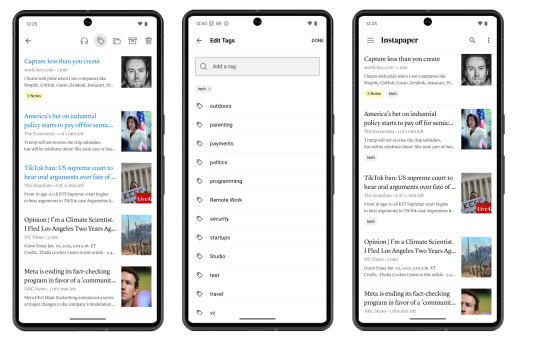
We added multiselect tagging in Instapaper Android 6.1 to make it much easier to organize your articles with tags in bulk. You can start multiselect by long pressing an article, select the articles you want to add tags to, and then tap the tag icon.
Other Features & Improvements
In addition to the above, Instapaper Android 6.1 has a handful of additional features and improvements:
Added OpenDyslexic font for readers with dyslexia.
Improved experience for e-ink readers by disabling more animations.
Fixed bug where screen would not lock with reader open.
Fixed issue where video thumbnails would show up duplicated.
Other minor crash fixes and improvements.
We’re excited to continue improving the Android app, and getting it up to parity with iOS and web. Please let us know if you have any feature requests, bug reports, or improvements you’d like to see on Android!
– Instapaper Team
36 notes
·
View notes